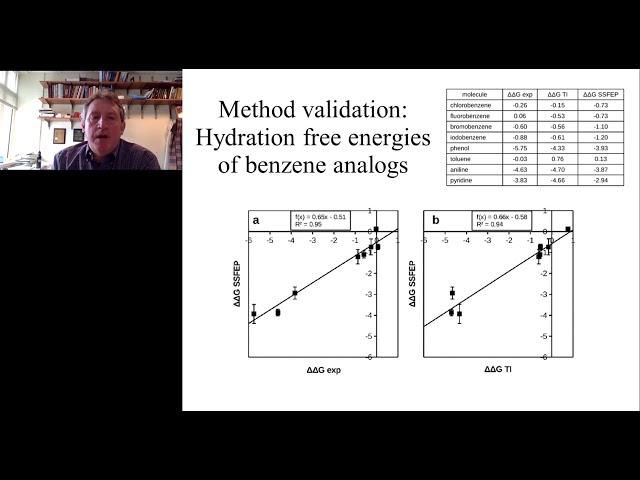
Can CADD Drive GPCR Drug Design? Rapid Estimation of Relative Binding Affinities Based on..
Presented at:
Drug Discovery 2018
Presented By:
Alexander MacKerell, PhD - Grollman-Glick Professor of Pharmaceutical Sciences, Director, Computer-Aided Drug Design Center, University of Maryland School of Pharmacy
Speaker Biography:
Alex MacKerell received a Ph.D. in Biochemistry in 1985 from Rutgers University, which was followed by postdoctoral fellowships in the Department of Medical Biophysics, Karolinska Intitutet, Stockholm, Sweden and the Department of Chemistry, Harvard University. In 1992 he assumed his faculty position in the School of Pharmacy, University of Maryland where he is currently the Grollman-Glick Professor of Pharmaceutical Sciences and the Director of University of Maryland Computer-Aided Drug Design Center. MacKerell is also Co-founder and CSO of SilcsBio LLC, a biotech company in the area of computer-aided drug design.
Webinar:
Can CADD Drive GPCR Drug Design? Rapid Estimation of Relative Binding Affinities Based on Pre-computed Ensembles
Webinar Abstract:
Rapid, accurate estimation of relative ligand affinities offers the potential to allow computational methods to direct drug design and development. Towards this goal we have developed two methods based on pre-computed ensembles; Site Identification by Ligand Competitive Saturation (SILCS) and Single-Step Free Energy Perturbation (SSFEP). SILCS is based on computational functional group affinity mapping (FragMaps) of proteins using oscillating μex Grand Canonical Monte Carlo/Molecular Dynamics (GCMC/MD) simulations that take into account contributions from protein desolvation, functional group desolvation, protein flexibility as well as functional group-protein interactions. The method can be applied to a range of macromolecules including those with deep or full inaccessible binding pockets such GPCRs and nuclear receptors. Grid Free Energy (GFE) FragMaps obtained from the GCMC/MD simulations may be used both qualitatively and quantitatively to direct ligand design. In SSFEP a lead compound-protein complex is subjected to MD simulations from which an ensemble of ligand-protein conformations is obtained. Similar calculations are done on the ligand in solution. Free energy differences associated with small chemical modifications of the lead compound may then be evaluated using the free energy perturbation formulation in the context of single step perturbations. Both SILCS and SSFEP allow for rapid scoring of 1000s of transformations on a daily time frame offering the potential to identify synthetically accessible ligands thereby facilitating decisions concerning compounds for synthesis and testing. An overview of the SSFEP and SILCS methodologies will be presented along with application of the methods in the context of lead compound identification and optimization in the context of GPCRs.
Earn PACE/CME Credits:
1. Make sure you’re a registered member of LabRoots (https://www.labroots.com/virtual-event/drug-discovery-2018)
2. Watch the webinar on YouTube above or on the LabRoots Website (https://www.labroots.com/virtual-event/drug-discovery-2018)
3. Click Here to get your PACE (Expiration date – 2 years from event)– http://www.labroots.com/credit/pace-credits/2684/third-party
LabRoots on Social:
Facebook: https://www.facebook.com/LabRootsInc
Twitter: https://twitter.com/LabRoots
LinkedIn: https://www.linkedin.com/company/labroots
Instagram: https://www.instagram.com/labrootsinc
Pinterest: https://www.pinterest.com/labroots/
SnapChat: labroots_inc
Drug Discovery 2018
Presented By:
Alexander MacKerell, PhD - Grollman-Glick Professor of Pharmaceutical Sciences, Director, Computer-Aided Drug Design Center, University of Maryland School of Pharmacy
Speaker Biography:
Alex MacKerell received a Ph.D. in Biochemistry in 1985 from Rutgers University, which was followed by postdoctoral fellowships in the Department of Medical Biophysics, Karolinska Intitutet, Stockholm, Sweden and the Department of Chemistry, Harvard University. In 1992 he assumed his faculty position in the School of Pharmacy, University of Maryland where he is currently the Grollman-Glick Professor of Pharmaceutical Sciences and the Director of University of Maryland Computer-Aided Drug Design Center. MacKerell is also Co-founder and CSO of SilcsBio LLC, a biotech company in the area of computer-aided drug design.
Webinar:
Can CADD Drive GPCR Drug Design? Rapid Estimation of Relative Binding Affinities Based on Pre-computed Ensembles
Webinar Abstract:
Rapid, accurate estimation of relative ligand affinities offers the potential to allow computational methods to direct drug design and development. Towards this goal we have developed two methods based on pre-computed ensembles; Site Identification by Ligand Competitive Saturation (SILCS) and Single-Step Free Energy Perturbation (SSFEP). SILCS is based on computational functional group affinity mapping (FragMaps) of proteins using oscillating μex Grand Canonical Monte Carlo/Molecular Dynamics (GCMC/MD) simulations that take into account contributions from protein desolvation, functional group desolvation, protein flexibility as well as functional group-protein interactions. The method can be applied to a range of macromolecules including those with deep or full inaccessible binding pockets such GPCRs and nuclear receptors. Grid Free Energy (GFE) FragMaps obtained from the GCMC/MD simulations may be used both qualitatively and quantitatively to direct ligand design. In SSFEP a lead compound-protein complex is subjected to MD simulations from which an ensemble of ligand-protein conformations is obtained. Similar calculations are done on the ligand in solution. Free energy differences associated with small chemical modifications of the lead compound may then be evaluated using the free energy perturbation formulation in the context of single step perturbations. Both SILCS and SSFEP allow for rapid scoring of 1000s of transformations on a daily time frame offering the potential to identify synthetically accessible ligands thereby facilitating decisions concerning compounds for synthesis and testing. An overview of the SSFEP and SILCS methodologies will be presented along with application of the methods in the context of lead compound identification and optimization in the context of GPCRs.
Earn PACE/CME Credits:
1. Make sure you’re a registered member of LabRoots (https://www.labroots.com/virtual-event/drug-discovery-2018)
2. Watch the webinar on YouTube above or on the LabRoots Website (https://www.labroots.com/virtual-event/drug-discovery-2018)
3. Click Here to get your PACE (Expiration date – 2 years from event)– http://www.labroots.com/credit/pace-credits/2684/third-party
LabRoots on Social:
Facebook: https://www.facebook.com/LabRootsInc
Twitter: https://twitter.com/LabRoots
LinkedIn: https://www.linkedin.com/company/labroots
Instagram: https://www.instagram.com/labrootsinc
Pinterest: https://www.pinterest.com/labroots/
SnapChat: labroots_inc
Тэги:
#Alexander_MacKerell #GPCR #CADD #drug_design_and_development #Drug_Discovery #Virtual_Event #WebinarКомментарии:
One line art #aram_nabeel #shorts #viral #fyp
Aram Nabeel
MBBS Education in Russia Fee
MBBS in Russia
ЕДУ НА ЛАДЕ ГРАНТЕ ПО ОСЕННЕМУ ГОРОДУ
DimaViper Live
El abecedario en español
Mi Jardin Infantil


























